|
This particular article from
a 1940 issue of Radio News magazine touches on two of my hobbies - airplanes
and Amateur radio. Whereas most of my flying experience is with all forms of models,
here is a group of Hams who provided logistical radio communications during the
3rd Open American Soaring Contest, held in Lockport, Illinois. W9USB was the call
sign granted by the FCC especially for the event. Such a contest requires administration
and coordination of air and ground aircraft movement, tow winch operation, pilot
status, event scheduling, and emergency services if required (fortunately, none
were). Being an all volunteer effort, the "Prairie Dogs" subdivision of the "Hamfesters
Club" of Chicago. As pointed out in the article, the highly successful operation
was a great public service demonstrating the capability and utility of Amateur radio.
Many major Ham equipment manufacturers donated items for the contest.
W9USB Third Open American Soaring Contest
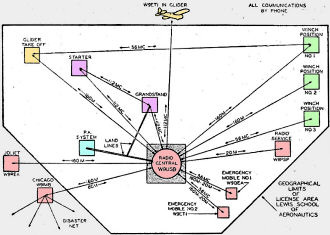
Sketch showing the field positrons which were in use at W9USB.
It looks - and was - quite complex.
by Karl A. Kopetzky, W9QEA, ex-W9USB
Managing Editor, Radio News, and Chief of Communications, 3rd Open American Soaring
Contest
Assembling what has been termed the greatest amount of equipment ever used for
so short a time, and certainly the greatest communication network ever to be used
in connection with a Glider Meet, W9USB went on the air for the ten days starting
August 24, through September 2, at Lewis School of Aeronautics, Lockport Airport,
Lockport, Illinois.
The main station, which was given the name of Radio Central for easy identification,
was located in one of the class rooms fronting on the airport. On a "U" shaped series
of tables were placed 5 transmitters, 9 receivers, 2 P.A. units and a interconnecting
board. The units were in use for an average of 10 hours per day on all phone frequencies
from 160 meters down to 112 megacycles.
In Radio Central were 2 Hallicrafter's 100-watt . transmitters, one 450·,watt
Hallicrafter's transmitter, one 56 mc. W9ETI unit, and one 112 mc. Abbott "souped-up"
unit. In the receiving department, the RCA AR77 stood watch on 160 meters. Hammarlund
HQ120X on 75 meter phone and 3105 kc. itinerant a.ircraft patrol, an RME 69 on the
broadcast band, and special Howard 437 on 275 kc. for aircraft weather, a Hallicrafter's
5-10 on 28 mc. phone, the W9ETI unit on 56 mc. phone, the Abbott on 112 mc. phone,
the National HRO on 14 mc. phone, and the Hallicrafter's SX25 on reserve, all band
duty.

Johnny Novak, the Flying Birdman, (he makes bird sounds) demonstrating
glider flight.
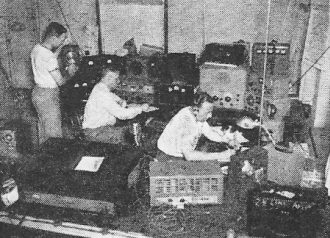
W9JU tunes the freq-meter, W9RRC gets out traffic, while W9VSX
qso's the field.
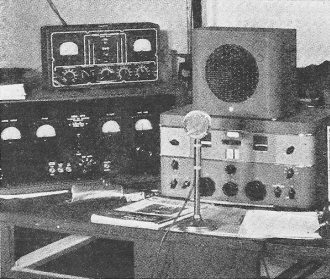
All 160 meter traffic was handled with the Hallicrafter transmitter,
Triplett modulation meter, and the RCA AR77 receiver.
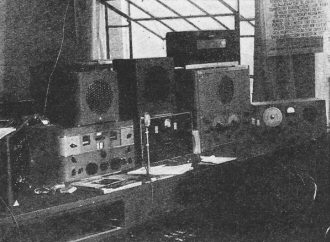
Moving along left hand side, the 75-meter & 3105kc Hammarlund
standby, the BC RME 69, and the WX Howard 437 receivers.
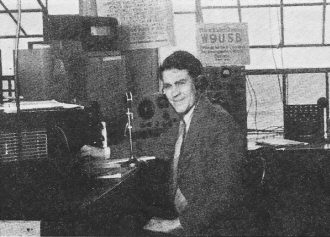
W9JID poses for his pix during a quiet moment at Radio Central.
Every op had a chance to work USB.
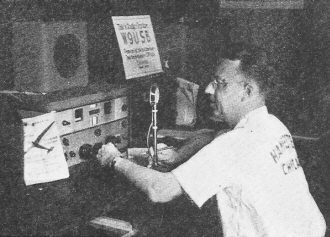
W9VSX who handed W9ETI his business card just before Ollie was
about to go up in a glider. VSX is a mortician.

Field end of the Radio Central. At left is the W9ETI unit used
on 56 MC. Center is patch-board; right, Abbott.
On the field were two and sometimes three "Prairie Dog Specials," home built
affairs, on 160 meter phone transmitting and receiving. The "Prairie Dogs" are a
subdivision of the "Hamfesters Club" of Chicago, engaged in A.E. C. work. Also there
was W9PSP with a 28 mc. portable transmitter and receiver, W9ETI with a 56 mc. transmitter
mobile and a 20-160 meter Howard built into his car as a receiver. W9QEA had his
car as an Emergency Mobile with a duplication of W9ETI's equipment plus an RCA AVR-15
aircraft receiver for immediate weather and beam reports from Chicago Airport on
the Lockport Field. In addition to this, there were never less than four and sometimes
as many as six 112 mc. transceivers and one or two 56 mc. transmitters and receivers
on the field occupied in one duty or another.
It was the work of W9USB, whose call-letters were specially granted by the Federal
Communications Commission, to coordinate the various phases of the meet. In this
capacity all manner of traffic was handled over the station, from a Disaster Flight,
similar to that one done in the East by W2USA, to finding mothers and fathers for
lost children.
Although it rained sufficiently for four days to turn the Airport into a sea
of mud in which more than one radio car got stuck, over fifty amateurs turned out
over the air and in person to make the radio end of the meet a huge and gratifying
success. Most active in participation was the Hamfester's Radio Club of Chicago,
whose members were rounded up by Warren H. Keller, W9RRC.
It is Warren's picture that graces our cover this month. Not only is he fond
of radio (he's a licensed ham), but he bore such a striking resemblance to President
Roosevelt in a characteristic pose, that we thought it too good to pass up. Incidentally,
Warren has worked in President Roosevelt's old law office, and is many times mistaken
for the Chief Executive whenever he is in Washington where his work as a Certified
Public Accountant occasionally takes him. W9RRC is 41, a native of Chicago, and
- believe it or not - that's his own cigarette holder (which Warren says he was
using long before FDR's became so famous) and his own hat. Warren states that he
doesn't mind being the President's double, except that some times it annoys him
to have people stare at him ... and another thing, he's a Republican. At the Glider
Meet everybody affectionately called him "Frank."
In the Disaster Flight, W9USB was the key station assigned to clearing planes
from the "outside" into Lockport which was the scene of the "simulated disaster."
Planes came in from as far away as 300 miles, having first cleared through local
hams with Radio Central. They were then instructed to land at Joliet, Illinois,
where through W9REA they were routed, one group at a time. to Lockport, with their
precious bundles of "simulated drugs, simulated blankets, and simulated nurses."
Enough credit cannot be given to W9IMB in Chicago who spent many hours standing
watch on the frequency of W9USB, keeping it clear, and rounding up hams in the outlying
districts. These hams obtained the names of the pilots, and the numbers of their
respective ships, and forwarded that information to Mr. Lawrence Lawver. Executive
Assistant of the Airplane Owners & Pilots Ass'n., sponsors of the Disaster Flight,
via W9IMB-W9REA-W9USB.
Special QSL cards were printed for the occasion and they were distributed to
all hamops who were contacted. An interesting sidelight on the QSL's is that they
were "glider flown." We believe that this is the first time that any ham QSL's have
so been treated. Each QSL bore the imprint of the Lockport Dedication Stamp, which
will make them rare keepsakes. Special Certificates of Meritorious Service were
also presented to those radio operators who were instrumental in making W9USB a
success. These are personally signed by the Most Reverend Bernard J. Sheil, Senior
Auxiliary Bishop of the Archdiocese of Chicago who for the Catholic Youth Organization
was one of the sponsors of the Meet.
While the work was gruelingly hard at times, and specially at the time of the
Disaster Flight when five transmitters and seven receivers were going at one time
at Radio Central, there were pleasant moments for all ops. Almost everybody had
a chance to fly, and some made their first "hops" at this Meet. Ollie W9ETI Read
distinguished himself by being one of the few hams who has ever had a glider flight.
On several occasions Ollie took up a 112 mc. transceiver with him and spoke to W9USB
from heights of over 6,000 feet. His conversations were heard in Chicago, over 38
miles away. Through the interconnecting board his conversations with W9QEA at the
mike of W9USB were put on the field's P.A. System and the crowd that attended were
treated both ends of the QSO. Incidentally. it was possible to put any receiver
on the P.A. System and the glider pilots made use of. this in getting their weather
reports, as well as orders which might have been originating anywhere's out in the
mile-square airport. Contacts through the loud-speaker system and the "Prairie Dog
Specials" was excellently done, and handy in emergencies. Even 112 mc. was pushed
through the P.A. System; and on one occasion W9QEA spoke to W9ETI via a route that
went like this: W9QEA (on 112 mc.) to W9USB, W9USB to W9ETI via the P.A. System.
W9ETI to W9USB via 56 mc., W9USB to W9JU via the P.A. System. W9JU to W9QEA via
160 Meters. Some of the hookups were "complex to the extreme, all as the occasion
might dictate.

Right hand side of Radio Central. Transmitter is for 14 MC with
the HRO as receiver. The SX25 is reserve.
The hams who participated and who were awarded Certificates of Service were:
W9=CNM, JID, ZKQ, VPO, AEG. DAA, DAB, CWP, ENX, ETI, FIB, HOD, HTI, HXO, IMB, IMN,
IWZ, IZI, JJP, JU, KBO, KKT, MTW, NIL, ONR. PEQ, PPQ, VRP, RRC, PSP, QEA, QPW, QYJ,
RBR, REA, SAQ, SXZ, TAL, TDF, TJD, VEZ, VRS, VSX, WZG, YZV, ZHR, ZYL, AVE, RDD,
QGG, MKW, VFW, and WJU.
The following radio firms lent their equipment and helped to make the W9USB end
of the Meet a success: Allied Radio Corp., Chicago; Amperite Company. N.Y.C.; Bliley
Electric Co., Erie. Pa.; Browning Laboratories, Winchester, Mass.; Bud Radio. Inc.,
Cleveland; Burgess Battery Company, Freeport. Ill.; The Hallicrafters, Inc., Chicago;
Hammarlund Mfg. Co., N.Y.C.; Howard Radio Co., Chicago; The National Company, Malden,
Mass.; Newark Electric Co., Chicago; Pioneer Gen-E-Motor Corp., Chicago; Presto
Recording Co., N.Y.C.; RCA Mfg. Co., Camden, N.J.; Radio Mfg. Engineers, Peoria,
Ill.; Radio News Magazine, Chicago, Shure Brothers, Chicago, and Triplett Electrical
Instrument Co., Bluffton. Ohio.
From the reports trickling back to us, the pilots of the gliders as well as those
who put on the Meet, were pleased beyond words with the operation of ham radio.
We believe that the presentation which was given to the public at the Meet, of what
ham radio can do, was excellent publicity, and did much to raise the esteem in which
the public holds the ham.
Posted December 27, 2021
|

















